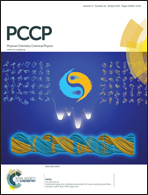Radical-induced, proton-transfer-driven fragmentations in [b5 − H]˙+ ions derived from pentaalanyl tryptophan†
Abstract
The collision-induced dissociation (CID) of [b5 − H]˙+ ions containing four alanine residues and one tryptophan give identical spectra regardless of the initial location of the tryptophan indicating that, as proposed for b5+ ions, sequence scrambling occurs prior to dissociation. Cleavage occurs predominantly at the peptide bonds and at the N–Cα bond of the alanine residue that is attached to the N-terminus of the tryptophan residue. The product of the latter pathway, an ion at m/z 240, is the base peak in all the mass spectra. With the exception of one minor channel giving a b3+ ion, the product ions retain both the tryptophan residue and the radical. Experiments with one trideuterated alanine established the sequences of loss of alanine residues. Formation of identical products implies a common intermediate, a [b5 − H]˙+ ion that has a `linear` structure in which the tryptophan residue is present as an α-radical located in the oxazolone ring, structure Ie. Density functional theory calculations show this structure to be at the global minimum, 14.6 kcal mol−1 below the macrocyclic structure, ion II. Loss of CO from the [b5 − H]˙+ ions is inhibited by the presence of the radical centre in the oxazolone ring and migration of the proton from the oxazolone ring onto the peptide backbone induces cleavage of an N–Cα or peptide bond. Three calculated structures for the ion at m/z 240 all have an oxazolone ring. Two of these structures may be formed from Ie, depending upon which proton migrates onto the peptide chain prior to the dissociation. The barrier to interconversion between these two structures requires a 1,3-hydrogen atom shift and is high (51.0 kcal mol−1), but both can convert into a third isomer that readily loses CO2 (barrier 38.7 kcal mol−1). The lowest barrier to the loss of CO, the usual fragmentation path observed for protonated oxazolones, is 47.0 kcal mol−1.
![Graphical abstract: Radical-induced, proton-transfer-driven fragmentations in [b5 − H]˙+ ions derived from pentaalanyl tryptophan](/en/Image/Get?imageInfo.ImageType=GA&imageInfo.ImageIdentifier.ManuscriptID=C5CP00178A&imageInfo.ImageIdentifier.Year=2015)

 Please wait while we load your content...
Please wait while we load your content...